Pichit Sheet – Explanation and Review
For several years, Pichit sheets has been popular among professional and hobby chefs in Japan. We tested it over an extended period.
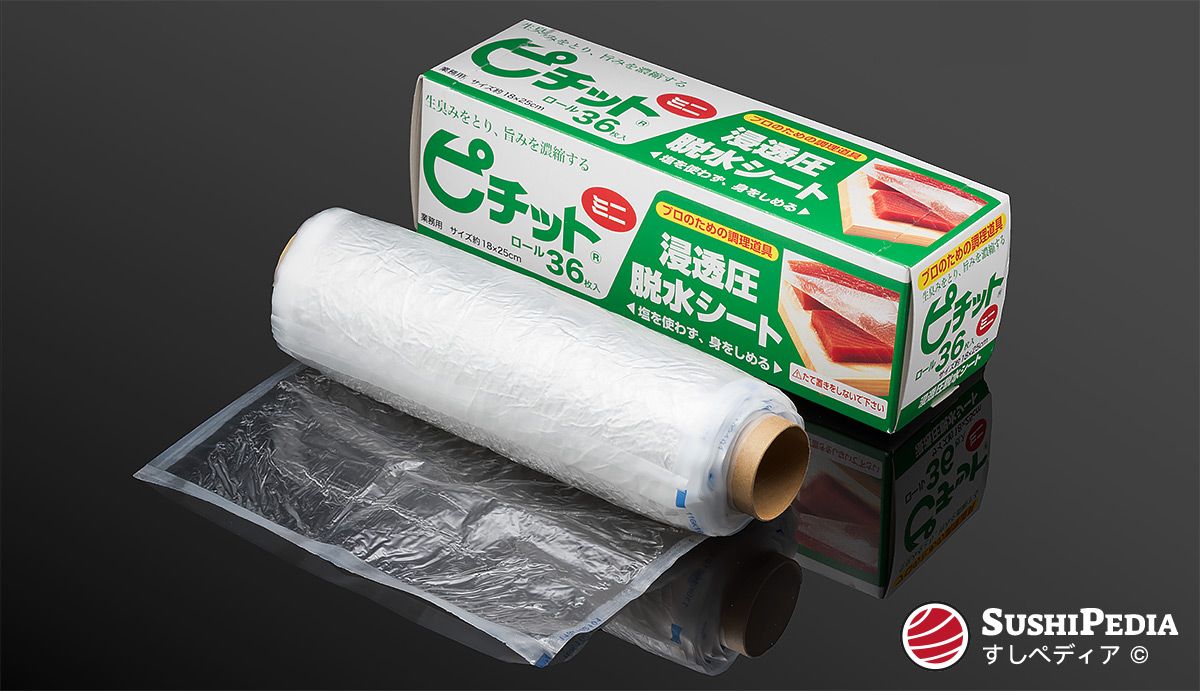
In our article, you will learn how Pichit sheets works and what experiences we have gained after more than a year of use.
Table of Contents
What Is Pichit?
Pichit sheet or foil (pichitto-shīto ピチットシート), also known as 'Pichitto,' is a contact dehydration sheet that enables the removal of water from ingredients, particularly meat, fish, and seafood. Pichit is manufactured by Okamoto and is highly effective at binding excess water from meat and seafood. This characteristic makes it a valued tool for both professional chefs and ambitious home cooks in Japan.
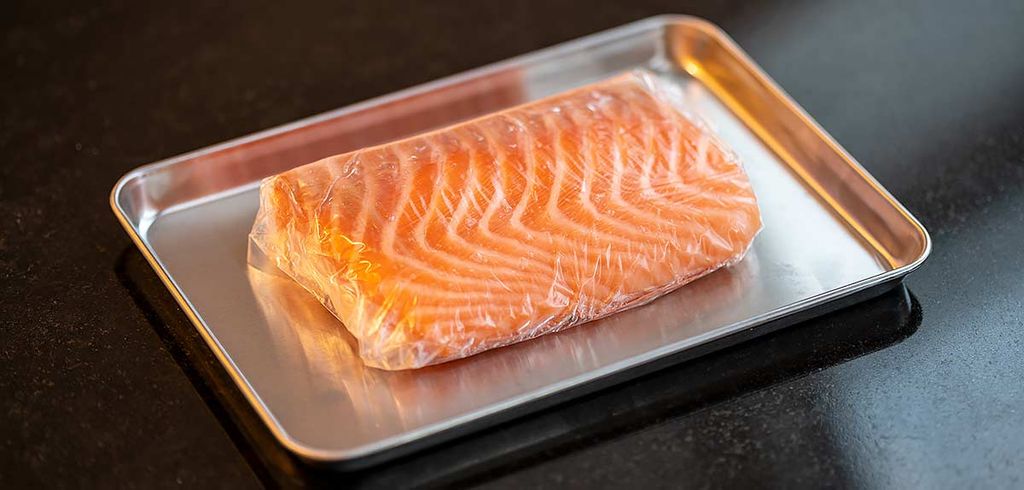
Sushipedia. Fresh Salmon in Dehydration Film for Sushi. All rights reserved ©
Pichit is used by wrapping food that needs dehydration in the foil and storing it in the refrigerator. The degree of dehydration depends on the moisture content of the ingredients, and the effectiveness of the sheet varies between lean and fatty meats. The dehydration system works more efficiently on lean meats like flounder than on fatty meats. The time required depends on the type, size, and origin of each fish. In addition to processing raw ingredients, a Pichit sheet can also be used to thaw frozen meat more gently by continuously drawing moisture away from the surface via the sheet.[1] For high absorption, such as for making dried fish, the meat is first salted and then wrapped in the sheet. Prolonged use of Pichit can be used to make dried foods (himono 干物).[2]
Advantages of Pichit
Reduction of Water Content
Although Pichit reduces the water content of food, it is not a substitute for traditional dry aging. During traditional aging, enzymatic processes break down the proteins in the meat, intensifying the flavor and altering the texture. This process also results in a significant loss of moisture, making the meat firmer. However, the loss of moisture likely has less impact on flavor than the enzymatic changes.[3] Nevertheless, water content has some organoleptic significance, especially when consuming raw fish, where sensory properties play a crucial role. Furthermore, moisture can provide a breeding ground for bacteria, which can affect odor and spoilage. Another positive effect of reduced water content is that meat better absorbs marinades.[4]
Reduced Drip Loss During Thawing

Sushipedia. Thawing Tuna with Dehydration Film. All rights reserved ©
Drip loss occurs primarily in foods that have been frozen and lose some of their tissue fluids during thawing. The extent of drip loss is significantly influenced by the freezing method and its speed.[5] High drip loss during thawing can negatively affect the overall flavor and texture. Additionally, if lipid oxidation-promoting substances are present in the tissue, this can lead to unpleasant odors and poor taste. By using a contact dehydration sheet, this liquid is continuously drawn from the meat, which can reduce quality loss and extend shelf life.[1][6]
If Pichit is left on the meat for too long during thawing, the surface of the meat may develop a less appealing texture. Depending on the intended use, it may be advisable to remove the skin from the meat before preparing sushi or sashimi. For large pieces requiring longer thawing times, it is also recommended to use a sheet type with lower absorption capacity (blue instead of green).
How Pichit Works
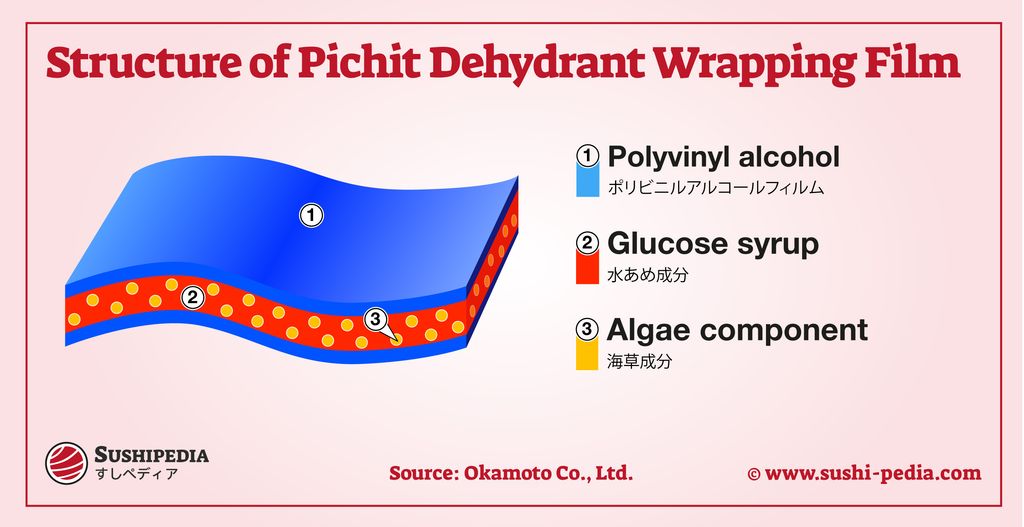
Sushipedia. Structure and Functionality of the Pichitto Film. All rights reserved ©
Pichit is a contact dehydration sheet for food, made by enclosing highly osmotic food sugar (glucose syrup) as a dehydration agent and water-containing algae component (sodium alginate E401) between two semipermeable polyvinyl alcohol membrane sheets. The algae component, or seaweed extract, is used to increase the viscosity and consistency of the glucose syrup (mizuame) ingredient.
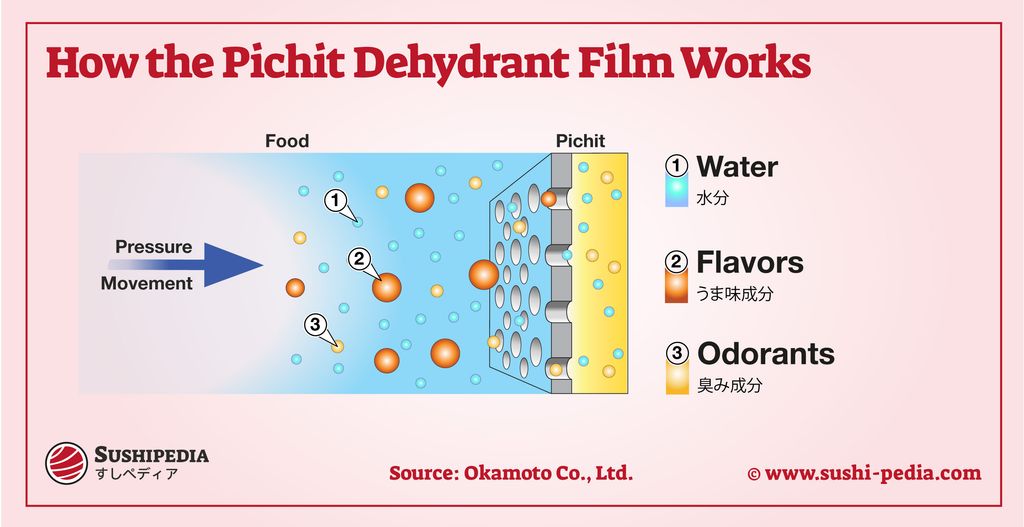
Sushipedia. Functionality of the Pichit Film. All rights reserved ©
When Pichit is used to wrap food, such as meat or fish, it removes excess water, odor components, and other low-molecular-weight substances through the action of osmotic pressure. The water-soluble molecules on the food's side create a chemical potential difference, ultimately causing the water to flow through the membrane.[4][7]
Pichit Variants
There are currently three types of Pichit sheets available on the market, which differ in their dehydration strength.
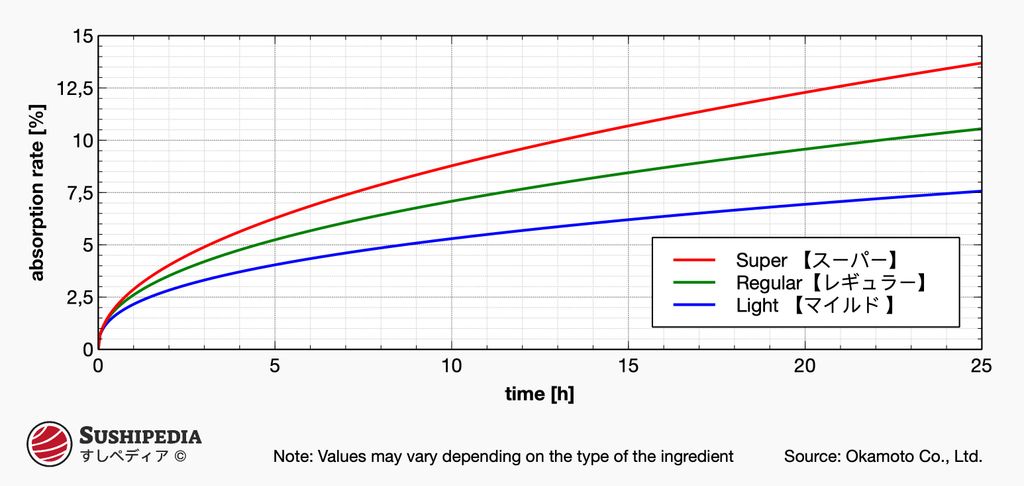
Sushipedia. All rights reserved ©
Pichit Low – Low Absorption (Blue)
The low absorption Pichit sheet type (マイルド <低吸収タイプ>) comes in a blue package. Of the three variants, it has the lowest absorption rate. Okamoto recommends it for use with ready-to-eat fish or sashimi. It is recommended for storing or managing the freshness of fresh ingredients such as sashimi.
Pichit Regular – Medium Absorption (Green)
The green-packaged Pichit (レギュラー <高吸収タイプ>) has a medium absorption rate. According to the manufacturer, it is particularly suitable for meal preparation, freezing, thawing, and long-term drying. Due to its moderate absorption rate, the manufacturer states that it is ideal for drawing moisture from food during thawing.
Pichit Super – High Absorption (Red)
Pichit with the highest absorption rate (スーパー <超高吸収タイプ>) is sold in a red package. According to Okamoto, it is particularly well-suited for producing dried fish and foods.
Recommendation
Regular Pichit sheet (green) has proven to be the most versatile in regular use. It is particularly well-suited for dehydrating freshly filleted fish in a short time without drying them out too much. Generally, the choice of the sheet depends on how long the food will be stored and how much water needs to be removed.
How to Use Pichit
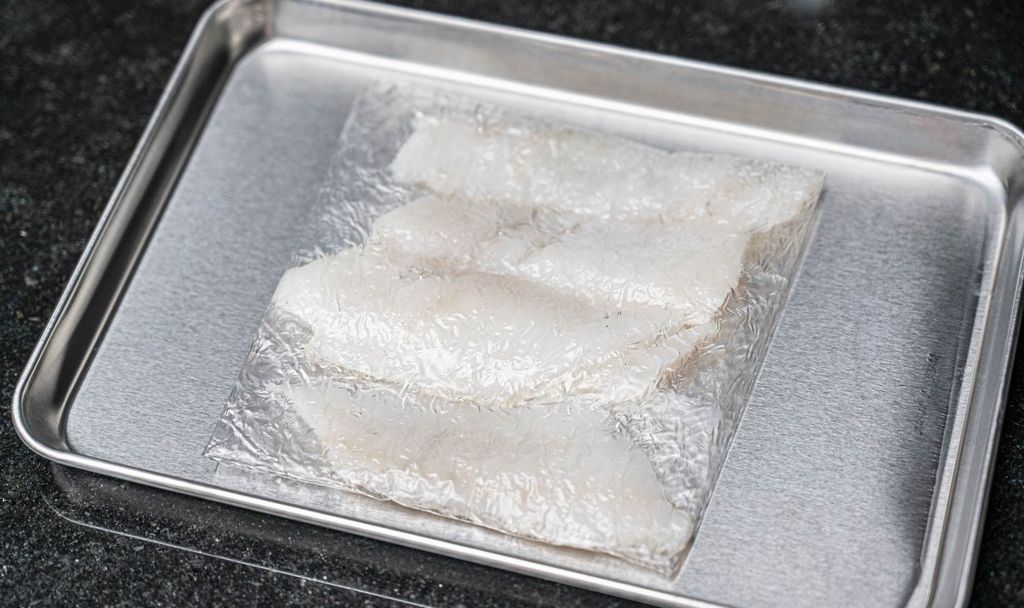
Sushipedia. Usage of Pichitto Film for Sashimi. All rights reserved ©
Although Pichit can also be used for whole fish, optimal results are achieved by using thin fillets, fillet blocks, or already sliced meat. Especially for sushi or sashimi preparation, better results can be achieved this way. The meat should be well cleaned, with the blood vessels drained and free of hematomas. The sheet should not be cut; otherwise, the contents or resulting liquid will escape. Both sides of the sheet are identical, so the top and bottom sides function the same. Place the meat on the sheet and wrap it tightly, ensuring that the sheet closely adheres to and completely encloses all sides of the meat. Any excess sheet can be folded or overlapped without concern.
The meat, wrapped in a sheet of Pichit, must now be stored under refrigeration. Over time, water will begin to accumulate inside the sheet. Depending on personal preferences and the type of meat used, consider how long the meat should be stored. During intermittent checks, pay attention to proper hygiene. For larger fillets or fillet blocks (saku), a longer application duration should be considered than for smaller pieces. When unpacking the meat, it may stick slightly to the surface of the sheet. Gentle and slow unpacking is recommended. After achieving the desired level of dehydration or drying, the meat can either be prepared directly or flavored with additional ingredients.
| Cut | Fat Content | Duration | Pichit |
|---|---|---|---|
| Fillet | High | 7 – 13 h | Green |
| Fillet | Medium | 5 – 10 h | Green |
| Fillet | Low | 2 – 6 h | Green |
| Sashimi | High | 3 – 5 h | Green |
| Sashimi | Medium | 2 – 3 h | Green |
| Sashimi | Low | 1 – 2 h | Green |
Pichit Versus Kombu-Jime
In the preparation method kombu-jime 昆布締め, fresh ingredients, typically fish or seafood, are carefully placed between layers of seaweed (kombu). This process uses the natural umami properties of kombu to enhance the flavor of the ingredients while extending their shelf life. The seaweed leaves not only transfer their flavor to the food but also improve texture by absorbing moisture and making the fish firmer. Kombu-jime is a valued technique in Japanese cuisine, often used in preparing sashimi and sushi to enhance the natural flavor of the ingredients. The process by which contact dehydration sheets like Pichit function differs from the mechanisms involved when using kombu-jime. However, the consistency or texture of the treated ingredients is similar at the end of the application. The flavor of ingredients treated with Pichit, however, remains significantly more neutral.
Our Experiences With Pichit
When preparing certain ingredients for sushi or sashimi, it is common to sprinkle them with salt (shio-jime) or sugar (sato-jime) before preparation. Sprinkling removes water and other substances from the meat, which can positively affect flavor and odor. However, sprinkling can also give the meat an undesirable salty or sweet aftertaste. To remove this, the meat is subsequently rinsed with either water or alcohol made from polished rice, such as sake. This washing or rinsing process, however, leads to some reabsorption of moisture. By using Pichit, there is the option to skip the salt or sugar. The final flavor remains intact, while substances responsible for odor are reduced.
In the following section, we explain our experiences with a selection of ingredients we regularly prepare. The following assessments are purely subjective and were carried out without scientific methodology. Some individuals preferred untreated meat, while others found the dry, firmer texture significantly more appealing. Regarding odor reduction, especially in fish with a strong natural odor, Pichit proved to be a suitable alternative to salt treatment (shio-jime).
Farmed vs. Wild-Caught
Not all ingredients benefit from the use of Pichit. In addition to particularly fatty fish, farmed fish can pose problems. Depending on the water quality and especially the composition of the feed, these can have a significant off-flavor. If the flavor is only subtly present in freshly killed specimens, it can be intensified by the use of Pichit.
Atlantic Farmed Salmon【Sāmon】
Several applications in the preparation of Atlantic farmed salmon have shown that its high fat content prevents sufficient water absorption. The flavor differences after five hours (block/fillet) were minimal. Only after 30 hours did a noticeable improvement in flavor appear. Better results can be achieved with less fatty salmon meat. Therefore, pieces from the leaner area are recommended.
Tuna【Maguro】
Lean tuna meat (akami) noticeably gains in flavor when combined with Pichit. After just one hour, an improvement in texture and flavor intensity is evident. However, with prolonged use, the meat becomes significantly firmer, and the color intensifies, which may not appeal to everyone. The fattier the meat, the less improvement we observed with the use of Pichit.
Marinated Tuna【Zuke-Maguro】
For the production of zuke maguro 漬けマグロ, thawed saku blocks of yellowfin and bluefin tuna were used. For lean meat, it is recommended to dehydrate for about two to three hours to achieve a good base for marinating. The treatment with Pichit allows the marinade to penetrate deeper into the meat.[4] The dehydrated tuna is then vacuum-sealed in a bag and marinated in soy sauce for 2 to 3 hours. The soy sauce content averages one-quarter in relation to the weight of the meat.
Japanese Amberjack【Buri, Hamachi】
The evaluation of the results using Pichit with Japanese amberjack meat, known as buri, varies greatly depending on personal taste preferences. For those who enjoy young Japanese amberjack from aquaculture, referred to as hamachi, its use is recommended. While the texture becomes firmer, the odor is reduced, and the flavor intensifies with a stronger umami aroma. When using wild-caught or larger specimens, the improvement was less pronounced. Especially when thawing frozen aquaculture hamachi, Pichit proved helpful. Due to the generally higher fat content, significantly longer application times should be considered.
Sea Bream【Tai】

Sushipedia. Preparation of Madai Sushi with Pichitto Film. All rights reserved ©
The meat of sea bream has a moisture content that is well-suited for the use of Pichit. The red sea bream (madai 真鯛) we used was from Japanese aquaculture and of good quality. The meat of the red-spotted sea bream is also similarly suitable. The filleted meat was already odor-free, very tender, and flavorful before applying Pichit. Through the application of Pichit, the meat noticeably lost water and became pleasantly firmer. The slightly sweet taste intensified, and the mineral aromas became more pronounced.
Flatfish【Karei】
The meat of most flatfish, such as hirame, has a relatively high water content, making treatment with Pichit suitable. The meat becomes firmer in a short time, and the mineral flavor intensifies. The use of the sheet is especially recommended during seasons when the meat has a higher fat content, as it maintains the 'melting sensation' despite increased firmness. However, the thin meat loses moisture relatively quickly, so the application time of Pichit should not be too long. Otherwise, the meat loses too much of its tender, pleasant texture. For larger fish caught during the cold season, we found an application time of five to seven hours to be a 'good' benchmark. After this time, the texture is comparable to treating the meat using the kombu-jime method.
For fatty meat, such as black halibut, the application time is extended. Flatfish caught in winter may also have a higher fat content than those caught in summer.
Sea Bass【Suzuki】
Sea bass is as well-suited for use with Pichit as for kombu-jime. The meat has a high water content, so the application time can be kept short, although generally slightly longer than with kombu-jime.
Conclusion
Regarding odor reduction, especially in fish with a strong natural odor, Pichit sheet has proven to be a positive alternative to the traditional salt treatment. Compared to the kombu-jime method, Pichit enables stronger dehydration, but avoids the typically desired flavor enhancement from seaweed aromas. In regular use, Pichit has proven most effective for white-fleshed fish (shiromi), such as flatfish, sea bass, and sea bream. However, seafood with very high water content, such as scallops, squid, and cuttlefish, lose too much of their characteristic texture. Fish prized for their aesthetic appeal (hikari-mono) are also less suitable for Pichit, as the sheet too strongly alters the skin surface. The thickness of the respective fillet or block should generally be considered when applying. These ingredients should be cut before using Pichit, similar to the use of kombu-jime. However, frozen ingredients can be used whole to reduce drip loss.
Pichit, like kombu-jime, should not be considered an obligatory step in preparing sushi or sashimi, but rather as a flavorful alternative or useful tool.
Transparency Notice
For transparency, it is noted that the mention of specific products or companies in this article is independent and without promotional intent. No fees were received for the creation of this text, nor were free products or services accepted by the author. Furthermore, the author has no direct or indirect business relationships with the entities mentioned, nor does he hold shares in them. The information and views shared here are solely for objective reporting and are based on an impartial evaluation.
References and Further Reading
- [1]保井 明子, 高島 薫子, 藤本 健四郎 (Yasui Akiko, Takashima Kaoruko, Fujimoto Kenshirō). 冷凍保存肉の食味に及ぼす脱水シートの影響 (Effects of Contact−Dehydrating Sheets on Flavor Scores of Frozen Meats). 3 29 207-211. 1996. DOI: 10.11402/cookeryscience1995.29.3_207.
- [2]宅野 雅巳、宅野 雅巳. 浸透圧脱水による魚類干物の製造の際の脂質の変化 (Changes in Lipids during the Drying of Fishes Using the Contact-dehydrating Sheet). 油 化学 (Journal of Japan Oil Chemists' Society) 39 (6) 409-413. 1990
- [3]Hyun Jung Lee, Juhui Choe, Minsu Kim, Hyun Cheol Kim, Ji Won Yoon, Sung Wook Oh, Cheorun Jo. Role of moisture evaporation in the taste attributes of dry- and wet-aged beef determined by chemical and electronic tongue analyses. Meat Science 151 82-88. 2019. DOI: 10.1016/j.meatsci.2019.02.001.
- [4]齋藤 利則、米田 千恵、飯島 久美子、畑江 敬子. マグロ肉への調味料浸透に及ぼす脱水シートの効果 (Permeation of Seasoning into Tuna Meat through a Contact Dehydration Sheet). 日本調理科学会誌 (Journal of the Japanese Society of Cooking Science) 38 (1) 63-66. 2005. DOI: 10.11402/cookeryscience1995.38.1_63.
- [5]Alain Le-Bail, Piyush Kumar Jha, Eds: Rémy Cachon, Philippe Girardon and Andrée Voilley. Gases in Agro-Food Processes, Chapter 7: Food Processing: All the Food Industry Sectors, Subchapter 7.1.3: Application—Freezing of Foodstuffs. Academic Press. 2019
- [6]浜田(佐藤)奈保子、齋藤利則、小林武志、 今田千秋、渡邉悦生. 魚の鮮度保持に及ぼす脱水シートの効果。 タラとタの比較 (Effect of Contact Dehydration Sheet on Fish Freshness. Comparison between Cod and Sea Bream). 日本調理科学会誌 (Journal of the Japanese Society of Cooking Science) 36 (4) 354-359. 2002. DOI: 10.11402/cookeryscience1995.36.4_354.
- [7]ピチット博士のコーナー、ピチットのしくみ (Dr. Pichitto Corner, How Pichit works). オカモト株式会社 (Okamoto Co., Ltd.). 2007. Source retrieved 4/23/2021
- 科学技術・学術政策局政策課資源室 (Resources Office, Policy Division, Science and Technology Policy Bureau). 日本食品標準成分表2020年版(八訂) (Standard Tables of Food Composition in Japan 2020 [8th edition]). 文部科学省 (Ministry of Education, Culture, Sports, Science and Technology). 2020. Source retrieved 4/23/2021